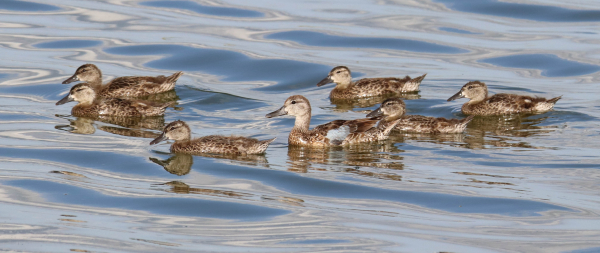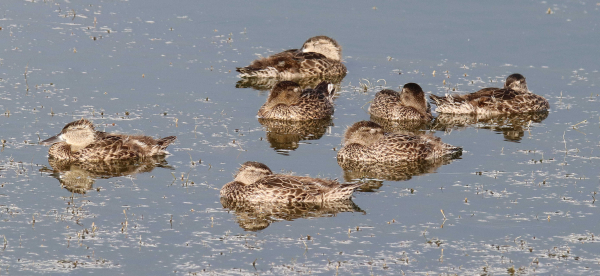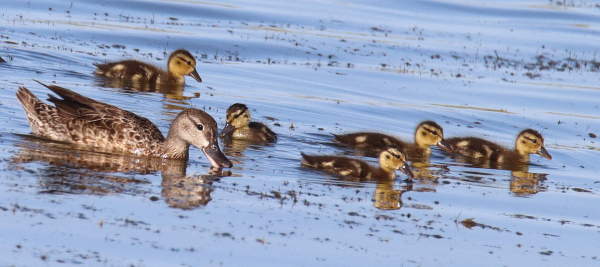
Little downy ducklings are just plain cute, and it seems I never get enough of seeing newly hatched broods being led by a female, watching them work their way along the edge of a shallow wetland. And photographing ducklings as they grow is not only enjoyable, it rivals meditation for the calmness it can bring. The ducklings always seem to get me closer in touch with the nature – the sights and sounds, the wind, sun and clouds, the water and plants, the insects and fresh air. All while sharing a corner of a shallow marsh with a brood of ducklings under the watchful eyes of the hen that laid their eggs, incubated them, and will care for the brood through fledging and beyond.
Every wildlife photographer wants to get good photos of a female duck with her downy brood, but every birder wants to photograph every species of ducks with a brood in their area, or at least as many as possible. Just as every species of duck is different with different male and female plumages, plus eclipse plumages, every species of ducklings is distinctive too. Blue-winged Teal tend to be tiny versions of Mallards, and Redhead and Canvasback ducklings are very yellow-colored, although the sloped head quickly distinguishes Canvasback ducklings. Conversely, Lesser Scaup ducklings are chocolate brown in color, and before they are a week old, Northern Shovelers already show the oversized bills their species is known for. It all adds a lot to our appreciation of ducks, their variety, and their similarities too.
I’m lucky to live in the midst of one of the best areas for nesting ducks in the United States, so I experience an almost weekly progression of the season simply by following the duck hatch. Early broods include Mallards and Northern Pintails, followed by Wood Ducks and Hooded Mergansers; then Blue-winged Teal and Northern Shovelers followed by Gadwalls, Redheads, Canvasbacks; and late to the party are broods of Lesser Scaup and Ruddy Ducks. Rare among the broods in my area are Ring-necked Ducks, Green-winged Teal, and American Wigeons, but they are all possible. The primary nesting ducks in the area are Blue-winged Teal, Mallards, and Gadwalls, so my photos tend to emphasize broods of these ducks.

Right now, I probably have more than 20 broods within a 3 mile area south and west of my office, so it’s pretty easy to find a few duck broods any time the sun is right and the wind is light or still. That provides great incentive to check for broods periodically, and last Saturday during prime late afternoon and evening sunlight, I made it a point to check back to Melody’s Marsh, about 5 times. It’s just a half-mile to the south, and each time I arrived a different brood, or a couple of them, was present; and more sedentary broods moved closer or farther from the roadway where I could access them with my mobile blind.
As anyone who reads my photography articles more than once knows, I like to use my vehicle as a mobile blind, which allows me to cover more areas, position myself at the best possible location, and a vehicle is much less likely to alert or displace the birds I’d like to photograph. My mobile blind also provides a comfortable seat, and permits me to move a few feet forward or back, to the side, and sometimes a little closer. I use the slightly raised window as a rest for my camera lens, or brace the lens against the side or top of the window frame.
As with any birds, and especially birds with young, approach slowly, cautiously, and indirectly if possible, keeping the sun behind you. If the hen reacts by calling the ducklings to gather, stop and let them settle back into their routine. Sometimes the hen will lead the ducklings away, but often she will keep a wary eye on your vehicle while permitting the ducklings to forage or rest.

It’s best to emphasize photographing broods at ease as they feed, and if the hen relaxes to feed too, so much the better. As soon as I turn off the engine, the ducks usually settle back to their activity; but if the hen begins to call and lead them away, I leave, hoping not to displace them. However, when I’m on foot the ducks react to my approach far in advance of getting into position for photographs – the adult females see people as another potential threat to their brood, which usually isn’t the case when my vehicle stops nearby.
In the Moment
Usually ducklings are in constant motion, so while photographing, pay attention to the duckling’s position and movements as best you can. Watch the direction they are facing and try to take your photos when they are showing the side of their face, or the front at an angle. Sometimes you can actually perceive a brighter look on the face of the hen and ducklings when the birds are in just the right position with respect to the sunlight. At the same time, watch the female and the position of her head; she will be the primary focus of any photo. Similarly, try to time your photos when the hen’s head is turned broadside – and focus on her eye; if the eye is in focus, the rest of the bird should be in focus too.

To ensure the female and ducklings are all in focus, or at least most of them, try to use a wide aperture, say an f10, to get a broader area in focus than with an f7, for example. If possible, try using an f14, if the shutter speed permits. As you increase the width of the area in focus, you lose shutter speed, but the ducklings shouldn’t be too active – they aren’t flying after all – so a 1/400 shutter speed should be sufficient to keep resulting photos sharp. With a brood that numbers between 5 and 12 ducklings, it can be difficult to get them all in focus if they are spread out while feeding or even following the female to another location. By providing the widest area in focus, you avoid having the ducklings in front or back of the group out of focus.
Then too, you can emphasize photographing when the brood is all on the same horizontal plane, so all are within the area you expect to be in focus. But realistically, it’s not necessary to get every duckling in a given brood in every photo. As you compose your images in the camera’s viewfinder, let your design eye balance the group as best you can as they feed, rest, or swim. Don’t be afraid to crop a duckling or 2 out of some photos – if it tightens up the group or adds to the look of the photo overall. You also have another chance to use your design eye when you are cropping your favorite photos using your photo editing software. Then you can always make 2 photos, 1 with fewer ducklings if it improves the look of the image, or when it simply provides a second pleasing photo.
Before you end your photo period with a brood, try taking some photos of a couple young ducklings close to the female; these images are always attractive and also show the range of growth from a tiny duckling to adult female. Take photos of a few ducklings without the adult too, they can be especially cute if you can zoom in close, or if the ducklings swim close to you. And that may be the most rewarding thing that can happen – when a brood of ducklings swims closer, accepting you as part of the landscape, or as a person they can trust up close.

As with any water-oriented birds, it’s nice to get close to water level for some photos; but don’t fret if you are slightly elevated, because that angle can provide a better view of a brood that’s a bit more spread out. The water itself plays a big role in the photos we take of duck broods, as any ripple or wave shows the action on the surface, and the color of the water depends on what’s being reflected from overhead – blue sky, gray sky, white clouds, or a combination of these; or maybe it’s the cattails or other emergent plants that are reflected in the water providing shades of green or yellow reflections. In some areas, bushes and trees may line a waterway or lake, providing other examples of a green reflection on the water.
Each year there are certain marshes that can be considered prime duckling “nurseries” where hens find ample almost-microscopic aquatic animals – tiny shrimp and other invertebrates including underwater ‘clouds’ of insect larvae that provide an abundance of high protein foods for fast-growing broods of ducklings. Melody’s Marsh, located just to the south of my office is a perennial duckling nursery, as it is for a variety of other birds.
Surrounding these nursery marshes are quality upland nesting areas composed of grasslands where upland-nesting ducks incubate their clutch of eggs for a bit more than 3 weeks before leading the newly hatched ducklings to the water’s edge for their first introduction to their water world. Diving ducks such as Canvasbacks and Redheads tend to build their nest above the water level on emergent plants such as cattails or bullrushes, so if you are looking for broods of these and similar species check wetlands with areas of this nesting habitat.

Timing, Lighting, & Weather
Of course, as with any bird photography, there are the elements of Timing with respect to Lighting and Weather to keep in mind. If it’s cloudy or windy, I usually opt for Plan B rather than trying to photograph – the birds tend to shelter from the wind, and without sunshine, a cloudy day just doesn’t provide adequate light for quality photographs. But during sunny mid-mornings and early evenings, when the wind tends to be calmer, I make the most of sunlight conditions, keeping the sun at my back as I photograph birds positioned in front of me – with my shadow pointing at the birds.
Mornings and evenings are also the periods when duck broods are most active, with more and more broods moving into the open as the sun begins to set. If I’m tempted by ducklings or other birds to photograph later in the evening usual, as the light dims I change my usual 400 ISO setting to 800 and, if necessary, dial my aperture to f7 or even f6 if necessary. These are obvious compromises due to lower light conditions, but it’s always worth a try when you just can’t break away from a late evening photo opportunity. Like I said, little ducks are just tooo cute, and I sure enjoy spending time with them on the edge of a prairie marsh each summer!
Article and photographs by Paul Konrad
Share your bird photos and birding experiences at editorstbw2@gmail.com